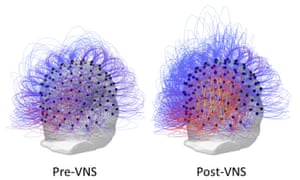
IPFS News Link • Science, Medicine and Technology
Nerve Implant 'Restores Consciousness' To Man In Persistent Vegetative State
• https://www.lewrockwell.comStimulation of the vagus nerve allows patient who had been in a persistent vegetative state for 15 years to track objects with his eyes and respond to simple requests.

On the right, the warmer colours indicate an increase in connectivity following vagus nerve stimulation among brain regions responsible for planned movements, spatial reasoning and attention. Illustration: Corazzol et al.
A 35-year-old man who had been in a persistent vegetative state (PVS) for 15 years has shown signs of consciousness after receiving a pioneering therapy involving nerve stimulation.
The treatment challenges a widely-accepted view that there is no prospect of a patient recovering consciousness if they have been in PVS for longer than 12 months.
Since sustaining severe brain injuries in a car accident, the man had been completely unaware of the world around him. But when fitted with an implant to stimulate the vagus nerve, which travels into the brain stem, the man appeared to flicker back into a state of consciousness.
He started to track objects with his eyes, began to stay awake while being read a story and his eyes opened wide in surprise when the examiner suddenly moved her face close to the patient's. He could even respond to some simple requests, such as turning his head when asked – although this took about a minute.
Angela Sirigu, who led the work at the Institut des Sciences Cognitives Marc Jeannerod in Lyon, France, said: "He is still paralysed, he cannot talk, but he can respond. Now he is more aware."
Niels Birbaumer, of the University of Tübingen and a pioneer of brain-computer interfaces to help patients with neurological disorders communicate, said the findings, published in the journal Current Biology, raised pressing ethical issues. "Many of these patients may and will have been neglected, and passive euthanasia may happen often in a vegetative state," he said. "This paper is a warning to all those believing that this state is hopeless after a year."
The vagus nerve, which the treatment targeted, connects the brain to almost all the vital organs in the body, running from the brain stem down both sides of the neck, across the chest and into the abdomen. In the brain, it is linked directly to two regions known to play roles in alertness and consciousness.































